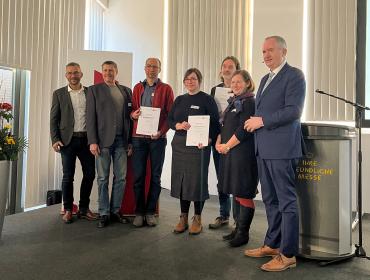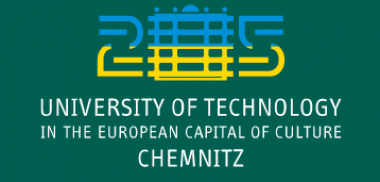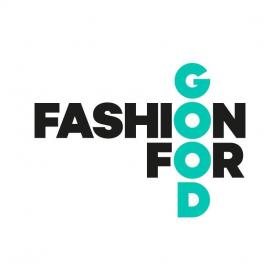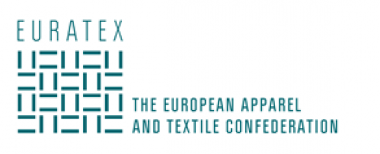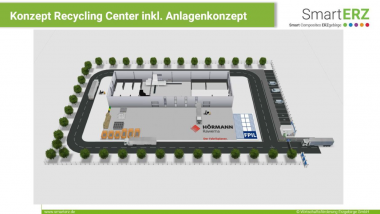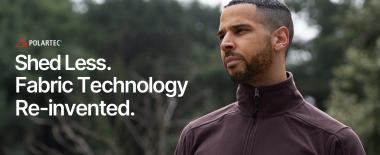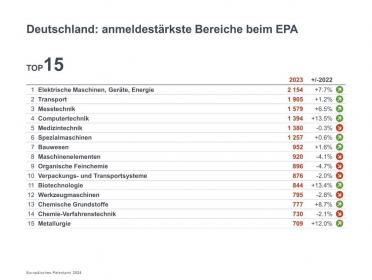STFI: Finalisten im Wettbewerb um Landesbaupreis 2024
Im Rennen um den sächsischen Landespreis „Baupraxis der Zukunft – nachhaltig, innovativ, zirkulär“ gehören zu den zehn Finalisten zwei Entwicklungen, die aus sächsischen Industrieforschungsprojekten erwachsen sind. Zum einen überzeugte das Holz-Textil-Faltwerk die Jury als innovatives Raumkonzept für modulares Arbeiten und Wohnen. Zum anderen fand die Jury Gefallen an einem Hybridbauteil für Holz-Beton-Verbunddecken, bei dem ein biobasiertes Hanffaserkunststofflaminat als Balkenverstärkung größere Spannweiten ermöglicht. Beide Projekte wurden am 8. März 2024 zur Preisverleihung im Rahmen der Baumesse HAUS in Dresden mit einer undotierten Anerkennung gewürdigt.
Holz-Textil-Faltwerke
Ein interdisziplinäres Entwicklerteam hat Holz-Textil-Faltwerke (HTF) konzipiert, die temporär zum Zweck des Schallschutzes, Sichtschutzes oder der räumlichen Abgrenzung aufstellbar sind. Die HTF sind selbsttragend und zeichnen sich durch kleines Packvolumen und Leichtbauweise aus. Unter Nutzung der Origami-Mathematik wurden mehrschichtige Holz-Textil-Verbunde entwickelt. Das Textil dient als zweidimensionales Scharnier der fertigen Konstruktion. Auf der Oberseite des Textils ist je nach technischer Anforderung eine entsprechende funktionale Schicht (z. B. Holz- oder Kunststoffelemente) zu fixieren. Dabei wird die Faltkinematik durch die Geometrie der biegesteifen Holzelemente bestimmt. Durch den Verbund aus biegeschlaffen textilen Materialien mit biegesteifen Holzelementen sind Faltbewegungen möglich, die eine selbsttragende Struktur entstehen lassen. Ein wahlweiser Einbau von Funktionselementen erhöht die Schallabsorption und -dämmung. Insgesamt entsteht durch die Origamifaltung von Holz und Textil ein ästhetisches Design. An der Entwicklung waren das Ressort Physik und Bauteile des Instituts für Holztechnologie Dresden gemeinnützige GmbH (IHD), die Hochschule für nachhaltige Entwicklung Eberswalde (HNEE) mit seinem Fachbereich Holzingenieurwesen sowie das Sächsische Textilforschungsinstitut e.V. (STFI) (Chemnitz) beteiligt.
Das IGF-Vorhaben 20946BR der Forschungsvereinigung Trägerverein Institut für Holztechnologie Dresden e.V. (TIHD) wurde unter dem Titel „Akustisch wirksame Origami-Faltwerke mit bedarfsgerecht anpassbarer Raumgeometrie auf Basis von Holz/Textilverbunden“ über die AiF im Rahmen des Programms zur Förderung der Industriellen Gemeinschaftsforschung (IGF) vom Bundesministerium für Wirtschaft und Klimaschutz auf Grund eines Beschlusses des Deutschen Bundestages gefördert
Gro-Coce – Zukunftsfähiges Hybridbauteil aus Holz, Beton und Hanffasern
Zukunftsweisende Materialien bieten die Entwicklungen aus dem Bereich nachwachsender Rohstoffe in Kombination mit biobasierten Harzsystemen. Ein interdisziplinäres Team modifizierte die Herstellungstechnologie von Holz-Beton-Verbunddecken. Das Forschungsprojekt Gro-Coce verfolgte das Ziel, durch die Verbindung nachhaltiger Bauprodukte und -weisen ein innovatives Deckensystem zu entwickeln, welches auf Grundlage der Holz-Beton-Verbundbauweise (HBV-Bauweise) als ökonomische und ökologisch vorteilhafte Alternative zu den momentan vorherrschenden, energie- und ressourcenintensiven Deckenkonstruktionen aus Stahlbeton funktioniert. Das Deckensystem besteht aus Holzstegen, deren Zugzone durch hochleistungsfähige hanffaserbasierte Armierungstextilien verstärkt wird. Dadurch gelingt eine deutliche Reduktion des notwendigen Holzquerschnittes und eine anforderungsgerechtere sowie verantwortungsvollere Nutzung des Querschnitts für alle üblichen Spannweiten des Hoch- und Geschossbaus. Ziel war die Nutzbarmachung bisher nicht erreichter mechanischer Kennwerte der Hanfbastfasern, durch die Entwicklung neuartiger Bastfasergewinnungs- und Aufbereitungsmethoden. Für die Entwicklung des neuartigen Deckensystems kooperierten die Partner Hanffaser Uckermark (Prenzlau), Holzbau Meyer (Stollberg/Erzgebirge), Hochschule für Technik, Wirtschaft und Kultur (Leipzig) sowie das Sächsische Textilforschungsinstitut e.V. (STFI), Fachbereich Web- und Maschenwaren, Verstärkungsstrukturen (Chemnitz). Das Forschungsprojekt ZIM KF4013848KI9 wurde unter dem Titel „Green organic reinforced high performance Timber Concrete Ceilings – Hanffaserkunststoffverstärkte, hochleistungsfähige und ressourceneffiziente Holz-Beton-Verbund-Decken“ über das Zentrale Innovationsprogramm Mittelstand (ZIM) vom Bundesministerium für Wirtschaft und Klimaschutz auf Grund eines Beschlusses des Deutschen Bundestages gefördert.
STFI Sächsische Textilforschungsinstitut e.V. Textilbeton Institut für Holztechnologie Dresden Bautextilien
Sächsisches Textilforschungsinstitut e.V. (STFI)


